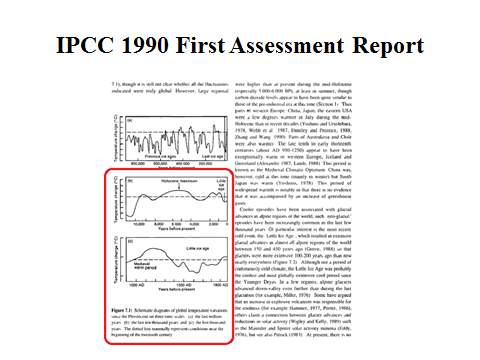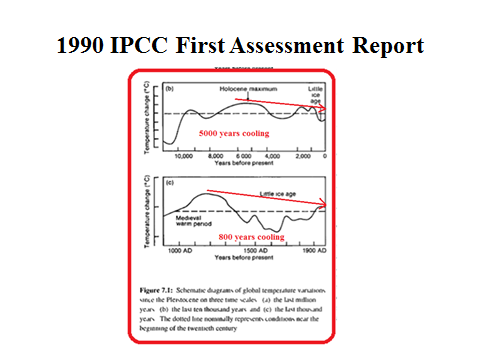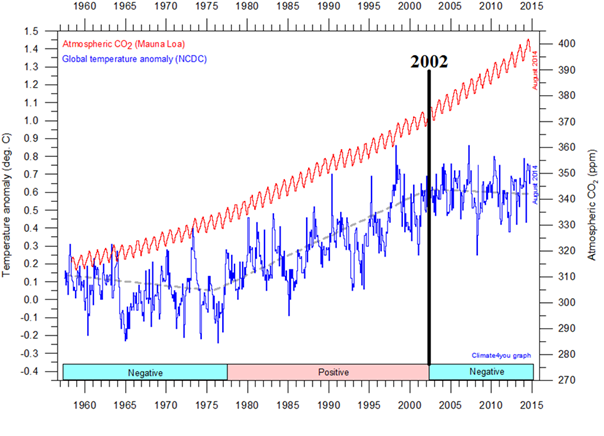By Norm Kalmanovitch, P. Geoph.
Resident Science Adviser to Friends of Science Society
Recently the press has been alive with stories of 2014 shaping up to be the ‘hottest on record’ http://www.cnn.com/2014/11/30/tech/innovation/record-temperatures – but Norm Kalmanovitch, P. Geoph. takes the media and NOAA to task for appearing to mislead ordinary citizens on climate change issues while omitting the larger historical warm periods and context.
Warming? What warming?
The world has been warming for over 300 years since the depths of the Little Ice Age so any record less than about 500 years long will make it seem as though today’s temperature is among the warmest “on record.” What is that record? 130 years (which would have begun at the end of the Little Ice Age when it was…cold! ) Or ~40 years of satellite data? For 18 of those years, temperatures have stagnated – sometimes showing a barely measurable rise of 0.05 degrees C. As German climate expert Hans von Storch said in a July 2013 interview with Der Spiegel: “In fact, the increase over the last 15 years was just 0.06 degrees Celsius (0.11 degrees Fahrenheit) — a value very close to zero.”
This is not the kind of warming people should worry about. Why isn’t NOAA announcing the story this way: “Though a slight temperature rise appears to make this the warmest year in contemporary records, this ‘rise’ is close to zero and we are still much cooler than previous historical periods before humans used fossil fuels in industry?”
This story appears to be a willful deception using a record that is too short to show the true state of the global temperature.
An honest portrayal of the global temperature record, as was the case in figure 7.1 in the IPCC 1990 First Assessment Report, will show that the world has been cooling for 5000 years since the Holocene Maximum and on a shorter time frame cooling for 800 years since the Medieval Warm Period.
If NOAA wanted to tell the truth about global temperature it would do the same as the NIPCC and use the record produced in 2010 by Ljungqvist showing that the Roman Warm Period and the Medieval Warm Period were both warmer than any temperature on the NOAA NCDC global temperature dataset.
Reference
Ljungqvist, F.C. 2010. A new reconstruction of temperature variability in the extra-tropical Northern Hemisphere during the last two millennia.Geografiska Annaler Series A 92: 339-351.
http://www.nipccreport.org/articles/2010/dec/15dec2010a4.html
Figure 1. Reconstructed extra-tropical (30-90°N) mean decadal temperature variations relative to the 1961-1990 mean of the variance-adjusted 30-90°N CRUTEM3+HadSST2 instrumental temperature data of Brohan et al.(2006) and Rayner et al. (2006). Adapted from Ljungqvist (2010).
Since NOAA does not seem able to differentiate cooling from warming over periods longer than their 130 year dataset, I annotated the graph with trend lines showing the current temperatures lower than the Medieval Warm Period.
Regardless of whether or not 2014 is the warmest year on the 130–year record it is certainly not warmer than temperatures of the Roman Warm Period or the Medieval Warm Period. The public needs to question the motivation of NOAA and the media in making this misleading statement.
NOAA should also show its dataset on the same graph as CO2 concentration and explain why its data shows slight net global cooling since 2002, even while atmospheric CO2 increases at the same rate as during the warming that occurred before 2002. (See graph from www.climate4you.com )
People should be asking NOAA to explain why all five global temperature datasets show the same slight net global cooling since 2002 – which is the same time period over which the World Radiation Center data shows that total solar irradiance (TSI) is decreasing.
Why is NOAA telling the American public that it is the ‘hottest year on record’ without telling people how long that record is, or that in context, this year’s temperatures are below the hotter times prior to fossil fuel use in the Minoan, Roman and Medieval time periods?
We think it is wrong to create public angst over the fear of global warming – especially when we are experiencing global cooling, however slight it may be. Children are particularly susceptible to this kind of fear mongering.
There are numerous factors that affect climate – in our view the sun is the main direct and indirect driver of climate change. However there are many cyclical atmospheric oscillations that have global impact, even though they are centered in one region. Find out more about the various aspects of climate science – see our website at www.friendsofscience.org
Norm Kalmanovitch, P. Geoph.







Leave a Reply! Please be courteous and respectful; profanity will not be tolerated.